Posts Tagged ‘Valletta’
-
A MATTER OF FATE
For British diplomat John Hookham Frere, January became a month of sorrows….
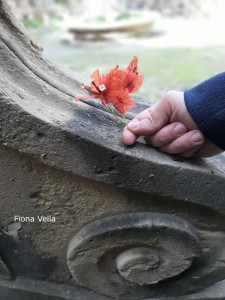 Some say that bad luck isn’t real and that there is no such thing as luck. Yet others would strongly avoid walking under a ladder or crossing the street in the presence of a black cat. They will certainly not open an umbrella indoors or drink any water that reflects moonlight, in the fear of attracting misfortune. Still, there are those who insist that whether you see it as lucky or unlucky, the chance event is the same. But is it?
Some say that bad luck isn’t real and that there is no such thing as luck. Yet others would strongly avoid walking under a ladder or crossing the street in the presence of a black cat. They will certainly not open an umbrella indoors or drink any water that reflects moonlight, in the fear of attracting misfortune. Still, there are those who insist that whether you see it as lucky or unlucky, the chance event is the same. But is it?John Hookham Frere, a British diplomat, poet, scholar and philanthropist, is not known to have spoken of bad luck. However, when years went by and he started to suffer the loss of his loved ones all during the same month, he lamented that January was becoming too melancholic for him.
Rumours say that his mother Jane, daughter of John Hookham (senior) who was a rich London merchant, had brought an astrologer’s silver cup as part of her marriage dowry. This cup originally belonged to her great uncle, John Dee, who was believed to be a conjurer. Legend said that he had used the cup to make some supernatural experiments but she insisted that this was not true. In defiance, she used the cup as a sugar bason.
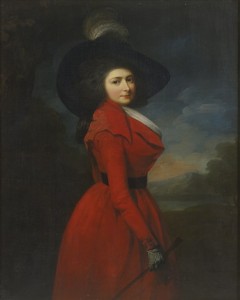 Curiously, the ‘January calamity’ had already struck the woman that Frere would eventually marry – Elizabeth Jemima Blake. A portrait painted by Sir Martin Shee shows her as a very beautiful girl with large dark eyes and masses of dark hair. In January 1790, she married George, sixteenth Earl of Erroll, who committed suicide in June 1798 after he confided an official secret to a friend who then published the communication and its author.
Curiously, the ‘January calamity’ had already struck the woman that Frere would eventually marry – Elizabeth Jemima Blake. A portrait painted by Sir Martin Shee shows her as a very beautiful girl with large dark eyes and masses of dark hair. In January 1790, she married George, sixteenth Earl of Erroll, who committed suicide in June 1798 after he confided an official secret to a friend who then published the communication and its author.The childless and beautiful widow met Frere in the year 1800 when she was recommended to stay in Lisbon to alleviate her mourning sorrows. At the time, Lisbon was a favourite health resort and Frere, who had just been appointed Envoy to the Court of Lisbon, was requested by a common friend to take care of her. Soon, the two became very good friends and along the years, they kept in contact through letters. Eventually, they got married on the 12th September 1816.
Lady Erroll never regained her health completely and this was a constant source of anxiety to her husband. A severe cold which she got while visiting the new rooms that were built at the British Museum for the Elgin marbles, wrought permanent damage to her constitution. A serious illness in 1820 obliged Frere to take her abroad and although she recovered some strength while travelling in the Mediterranean, it was clear that she would not survive the cold English climate.
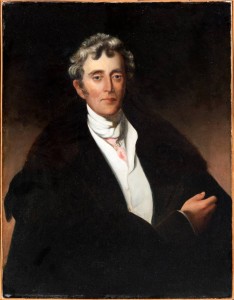 Since Frere preferred to live among English subjects, he chose to move to Malta. His sister Susanna, who had never married and who offered to help him to take care of his wife, joined them too. Initially, they resided in Casa Correa, a palatial building in Old Bakery Street, Valletta. Later on, they moved to Pietá, where they acquired two adjoined buildings, so that Susanna could live close by. This house on the waterfront helped Elizabeth to recover to better health and Frere began to show interest in the Maltese Islands which were so rich in history.
Since Frere preferred to live among English subjects, he chose to move to Malta. His sister Susanna, who had never married and who offered to help him to take care of his wife, joined them too. Initially, they resided in Casa Correa, a palatial building in Old Bakery Street, Valletta. Later on, they moved to Pietá, where they acquired two adjoined buildings, so that Susanna could live close by. This house on the waterfront helped Elizabeth to recover to better health and Frere began to show interest in the Maltese Islands which were so rich in history.Frere was very proficient in languages, namely Greek, Latin, Italian, French and Spanish. In Malta, he extended his knowledge in the Maltese and Hebraic languages. His ample library filled with prestigious and rare books became renowned with scholars, some of whom came to visit from abroad. At this time, he met Mikiel Anton Vassalli, a Maltese writer, linguist and philosopher.
Vassalli was expelled from Malta a number of times due to his political beliefs. His troubled life led to much difficulties and Frere helped to alleviate some of his problems. He financed the education of his three sons, supported him to publish his books and helped him to start teaching at the University of Malta as the first Professor of Maltese language. Frere’s remarkable kindness persisted even after Vassalli’s death, on 12th January 1829, when he took the responsibility of his burial in the then Protestant cemetery of the Msida Bastion, after the Catholic Church refused to do so due to his alliance with the Protestants.
Almost two years later, Frere had to return to these burial grounds again, this time to bury his wife when she passed away on 17th January 1831. His wife’s loss overwhelmed him with grief but he refused to return to England even though his relatives and friends advised him to do so. Eventually, he decided to acquire the steep hill behind his house in Pietá, turning the landscape into a set of lovely fertile terraces that were embellished with refined temples. From these peaceful gardens, he could look out at the cemetery where his beloved was resting.
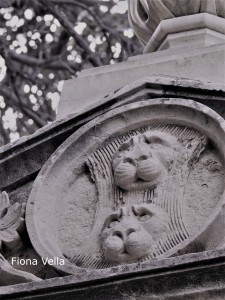 Yet the ominous month was set to claim another victim, this time his sister Susanna who died on the 18th January 1839, eight years and a day following the demise of his wife.
Yet the ominous month was set to claim another victim, this time his sister Susanna who died on the 18th January 1839, eight years and a day following the demise of his wife.In some letters which Frere wrote to his relatives and friends, he expressed his regret that the penalty of a long life was to see all those whom he had loved wither away and die. While his earlier years had been dedicated to political writing and literary satires, he passed the last years of his life composing epitaphs.
Instead of bringing an elation of joy at the beginning of a new year, January became acutely associated with death and Frere simply hated it. Who could have told him that this month would ultimately also claim his life – on 7th January 1846.
Currently, Heritage Malta holds the title for the iconic gardens of Villa Frere in Pietá. In February 2019, Heritage Malta and the NGO Friends of Villa Frere, signed a partnership and management agreement for the promotion, public availability, and the running and operation of the historical site.
The gardens of Villa Frere are opened for the public once a month or by appointment for groups. For further information, contact the NGO Friends of Villa Frere on Facebook or by email on villafrere@gmail.com
(This feature was published in the SENIOR TIMES – JANUARY issued with the Times of Malta dated 24 January 2020)
-
THE SELLING GAME
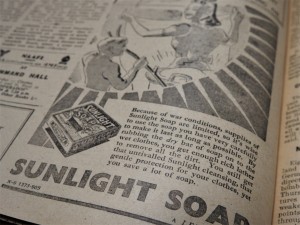 Advertising is said to reflect the societal tastes, beliefs and norms. By looking back at the adverts that were published in the Times of Malta at the end of the years 1939 to 1944, this becomes very clear. Yet even their absence during the days of war have much to say.
Advertising is said to reflect the societal tastes, beliefs and norms. By looking back at the adverts that were published in the Times of Malta at the end of the years 1939 to 1944, this becomes very clear. Yet even their absence during the days of war have much to say.There are whole studies and much research behind advertising. Adverts are used as a form of communication intended to convince an audience to purchase or take some action upon products, ideals or services. Their regularity aim to impact on memory to create a sense of familiarity and trust to buy those products.
Indeed, while turning the pages of November – December 1939 and 1940 of the Times of Malta, it is evident that a group of particular brands are always featuring. Most relate to health, beauty, alcohol, insurance, entertainment (mainly cinema), fashion and gifts.
Health adverts at the time generally focus on irritability of the stomach, laxatives, cold and fever, rheumatism, eczema, fatigue and sleeplessness. The message on the adverts is mainly delivered through drawings and long descriptions about the benefits of using the products.
 The text is generally presented in the form of a conversation – “Why continue to be agonised by Terrible Headaches, Niggling Nerve Pains, Black Depression, and Heavy-Limbed Lassitude?” – reads the introduction of an advert for tonic tablets.
The text is generally presented in the form of a conversation – “Why continue to be agonised by Terrible Headaches, Niggling Nerve Pains, Black Depression, and Heavy-Limbed Lassitude?” – reads the introduction of an advert for tonic tablets.“Do you realise the danger? Impure blood causes disease.” – says another advert selling a ‘blood mixture’ as ailment against rheumatism, lumbago, eczema, boils and pimples.
Communication with the readers is stark and direct – The word “Poisoned!” in capital black letters runs over the mouth of a man in the advert of a toothpaste. “Pyorrhoea has robbed him of his teeth, poisoned his whole system. Don’t let this happen to you.”
“Is running a house too much for you?” reads the title of an energy drink. “Do you feel that the cares of the household get you down and managing your servants is a strain?”
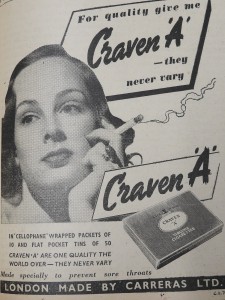 The quantity of adverts focusing on health issues form quite a big chunk of the advertising at the time. However, ironically, these are accompanied by cigarette adverts, one of which shows a beautiful young woman with a cigarette in her hand. A section of the advert text reads – “Made specially to prevent sore throats.”
The quantity of adverts focusing on health issues form quite a big chunk of the advertising at the time. However, ironically, these are accompanied by cigarette adverts, one of which shows a beautiful young woman with a cigarette in her hand. A section of the advert text reads – “Made specially to prevent sore throats.”Some of the adverts published at the time will certainly be unacceptable nowadays. Social class differences, sexism and offensive messages are quite typical.
“Women who belong to the 1st sleep group never grow old before their time. There are 3 groups. Which do you belong to?” – asks an advert selling Horlicks. “Most attractive women belong to the 1st sleep group.” – states another one. “Men who are sure of themselves belong to the 1st sleep group.” – and – “Men who get on in life nearly all belong to the 1st sleep group”.
 “Don’t look old! Tint those grey hairs with Shadeine.” – jumps at you an advert selling hair colour.
“Don’t look old! Tint those grey hairs with Shadeine.” – jumps at you an advert selling hair colour.Advertisements can influence strongly how we perceive things around us. By showing a high social class user of a product, the advert creates a longing or a pressure to purchase that item in order to belong to that level of society.
A skin-vitamin cream portrays the drawing of a beautiful lady, all dressed up in perfect make-up, set-up hair, a pair of lovely earrings and a crown. – “Lady Grenfell is one of the most beautiful among the young marrieds in Society…. She tells us, ‘I’m using Pond’s Creams containing the ‘skin-vitamin’, and they’re really amazing.”
“Many army and royal navy officers enjoy the comfort of our hand-made footwear. Why Not you? Sir.” – entices an advert showing the drawing of a highly elegant man sitting in a luxurious armchair while a shoe-maker sits on a stool to help him try on a new pair of shiny “Best English leather”.
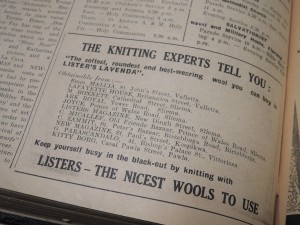 A shade of the effects of the Second World War, even though not yet happening in Malta is already present in adverts of 1939.
A shade of the effects of the Second World War, even though not yet happening in Malta is already present in adverts of 1939.“Keep yourself busy in the black-out by knitting with Listers – the nicest wool to use.” – advices an advert. “Bernards suggest that you give sensible gifts this Christmas. Such gifts as shirts, pyjamas, handkerchiefs, ties, socks, gloves and wool-slipovers all make very acceptable presents.” – recommends another one.
Not only adverts diminish in 1941 during the war days in Malta. Even the newspaper itself shrivels to a few pages although being published daily.
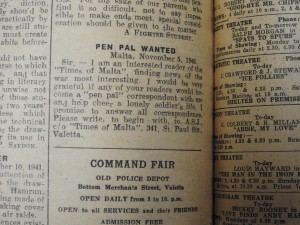 “Test your gas mask. Gas Chamber at Castile Place today.” – reads a warning advert on the front page of the Times of Malta on Tuesday, November 4, 1941. “There is no better way of ensuring that the respirator is still properly functioning than by putting it on and entering the gas chamber.”
“Test your gas mask. Gas Chamber at Castile Place today.” – reads a warning advert on the front page of the Times of Malta on Tuesday, November 4, 1941. “There is no better way of ensuring that the respirator is still properly functioning than by putting it on and entering the gas chamber.”Amid the difficulties of war, an advert speaks out the request for a pen pal – “I am an interested reader of the “Times of Malta”, finding news of the war most interesting. I would be very grateful if any of your readers would become a “pen pal” correspondent with me and help cheer a lonely soldier’s life.”
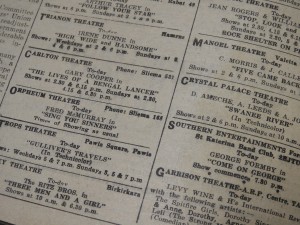 A considerable decrease of adverts continues in 1942. Alcohol adverts drop out completely. Cinema continues regularly in the following theatres – Manoel and Coliseum in Valletta, Gaiety, Majestic, Carlton and Orpheum in Sliema, Odeon, Thrianon and Rex in Ħamrun, Prince in Birkirkara, Buckingham and Royal in Żabbar, and Empire in Paola.
A considerable decrease of adverts continues in 1942. Alcohol adverts drop out completely. Cinema continues regularly in the following theatres – Manoel and Coliseum in Valletta, Gaiety, Majestic, Carlton and Orpheum in Sliema, Odeon, Thrianon and Rex in Ħamrun, Prince in Birkirkara, Buckingham and Royal in Żabbar, and Empire in Paola.“What do I do…. about the black market?” runs an advert issued by the Information Office. A Wartime Reminder advert issued by the same Office reminds people that “Imported Fuel is used for pumping Water. Reduced consumption of water saves Fuel. A saving in Fuel saves Freight, (and) Saving in freight helps to win the War.”
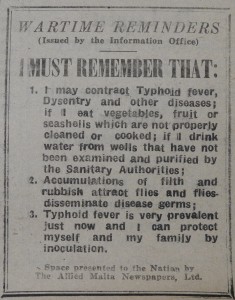 Another Wartime Reminder recommends the adequate washing of vegetables, fruit and seashells, and their proper cooking while warning against the accumulation of filth, since these may lead to Typhoid fever and Dysentry. Inoculation against the Typhoid fever is also advocated.
Another Wartime Reminder recommends the adequate washing of vegetables, fruit and seashells, and their proper cooking while warning against the accumulation of filth, since these may lead to Typhoid fever and Dysentry. Inoculation against the Typhoid fever is also advocated.The siege on the Maltese Islands effectively ended in November 1942. Yet adverts show that life took time to return to normal especially since the Second World War had not yet ended in other countries.
An advert issued by the N.F.U advices to eat cabbage and cauliflower to keep fit. Another advert informs its clientele that “Because of war conditions, supplies of Sunlight Soap are limited, so it’s wise to use the soap you have very carefully to make it last as long as possible.”
Even tennis balls were restored instead of purchasing new ones – “Hand in your old Tennis Balls to any of the Sports Dealers named below, who will forward them to Slazengers for renovation by a special process which includes reinflation and provision of a new outside cover.”
During the days of war, a few selected companies such as Bovril, managed to stay in the public eye through advertisements. “Makes all the difference between bread and butter.” The Bovril advert states. “A 4-oz. Bottle of Bovril makes over 100 delicious sandwiches.”
 Other adverts such as the one for Dettol portrayed the company’s involvement in the war efforts and reminded that the product should be used with “measured care” in order to keep the supply flowing.
Other adverts such as the one for Dettol portrayed the company’s involvement in the war efforts and reminded that the product should be used with “measured care” in order to keep the supply flowing.Marketers have always adapted to changing business demands when it comes to creating new advertisements. However, there are moments when their creativity is quite shocking – “Imitating Hitler” screams the title in bold capital letters of the British American Dry Cleaning Co.
(This feature was published in the Christmas Supplement issued with the Times of Malta dated 1st December 2019)
-
Gone but not forgotten
“St. George Preca used to say that the cemetery is the biggest book and I had the opportunity to confirm that,” revealed a Capuchin friar who served as a custodian of the Addolorata cemetery for some years. Living among the dead, day and night, helped him to learn much about humanity and its weaknesses.
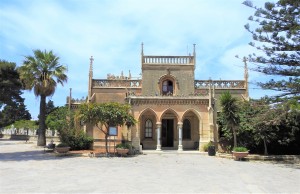 “The Capuchin friars were selected by the British authorities to administer this cemetery because they were loved by the locals. They had always been the ones who stood by the people during the worst moments and in situations which others avoided,” explained researcher Eman Bonnici.
“The Capuchin friars were selected by the British authorities to administer this cemetery because they were loved by the locals. They had always been the ones who stood by the people during the worst moments and in situations which others avoided,” explained researcher Eman Bonnici.“The British authorities hoped to attract people to bury their dead at the Addolorata cemetery. One of the best architects, Emanuele Luigi Galizia, was chosen to design this magnificent cemetery which took seven years to construct at the expense of £33,000. However, a well thought strategy was also required since this necessitated a considerable culture change within Maltese society.”
“Around 150 years ago, no one was buried in a cemetery except for those who died of contagious diseases or prisoners who were hanged. People buried their loved ones within the churches, chapels and crypts of their towns and villages to keep them close and within sacred grounds. Yet authorities considered this custom as a time bomb for some epidemic catastrophe. From time to time, outbursts of plague and cholera appeared on the islands, and it took days before the malady was identified. Case in points were the first plague victims of 1675 and 1813. Both were buried at Ta’ Ġieżu in Valletta, right at the capital city which was densely populated.”
“Initially, the Addolorata cemetery was intended to serve as a burial site for Catholics who were from Cottonera, Floriana and Valletta. As an incentive to start a new chapter in burial custom, those who had a private grave in any of these areas, were offered the possibility to choose a space in this cemetery and their grave would be dug for free. They were also given the privilege to use the cemetery’s church for burial rites and prayers before their loved ones were laid to rest. A further benefit consisted of a daily mass which was celebrated in this church and dedicated to all those who were buried within the cemetery.”
“Although a new law passed in 1863 prohibited further burials within churches, and the Addolorata cemetery was blessed and consecrated in 1869 to be ready for use, it was not that easy to convince the local population who had very strong beliefs related to death and burial customs. No one wanted to bury their dead in the new cemetery. Until one day, a poor woman from Naxxar who lived in Mosta, 64 year old Anna Magro, died at the general hospital, and since she had no relatives, she was the first one to be buried at this cemetery. Some time later, a number of people from Cospicua decided to accept the offer to have their own graves at the Addolorata, and from then, things moved on.”
The custodian’s role of the Addolorata cemetery was quite challenging. He had the responsibility of all the administration of the cemetery which included the registration of burials, the issuing of burial permits, the applications for new graves, the research for the public about the deceased and their graves, the maintenance of the cemetery and its church, the management of the workers, the distribuition of salaries which was still given out in money, the celebration of daily mass, and the hearing of confessions and spiritual advice.
“Originally the friars who acted as custodians were expected to spend the night at the cemetery. I spent around five years living at the cemetery together with a brother who was responsible to cook for me and to take care of the cemetery’s church. Although the brother resided at the cemetery for the whole year, friars alternated every week,” explained the friar.
“I was shocked when I was requested to become a cemetery custodian. I had studied philosophy and theology, and I had no idea whatsoever about the administration of a cemetery. However, my Provincial promised me that he would provide me with all the necessary assistance and so I accepted the role.”
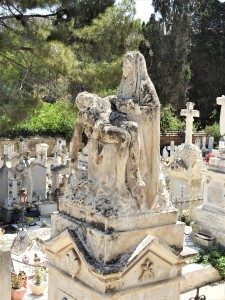 “Ironically, this work was a blessing in disguise! I had never imagined that the very place connected to death would fill my life with such significant experiences. A cemetery gets you in contact with all the levels of society, from the poorest to the richest, from the average person to the most successful. You learn a lot about humanity’s weaknesses and strengths, about love and hate, about repentance and revenge, about the excruciating suffering of illnesses and death. Ultimately, when the time came, it was actually difficult to leave this role.”
“Ironically, this work was a blessing in disguise! I had never imagined that the very place connected to death would fill my life with such significant experiences. A cemetery gets you in contact with all the levels of society, from the poorest to the richest, from the average person to the most successful. You learn a lot about humanity’s weaknesses and strengths, about love and hate, about repentance and revenge, about the excruciating suffering of illnesses and death. Ultimately, when the time came, it was actually difficult to leave this role.”“Some of my experiences at the cemetery are simply unforgettable. Some of them fill me with distate, others chill me to the bone, while a number of them remind me of the unexplainable power of prayer, love, hope and belief. At times, the pain and suffering which I had to deal with became unbearable and I had to seek out the comfort of the convent. More than the freezing cold of the night which reigned within those historical rooms, it was the distressful questions which people confronted me with, day after day, which affected me most.”
“Why is your God doing this to me?” asked a woman while carrying her sixth dead foetus for burial. “Her husband had brought the previous five and I had prayed with him and listened to his suffering. It was the first time that I was facing his wife and the news of yet another miscarriage was intensely sad and shocking. In moments like those, I asked God to guide me and he never failed to assist me. This is not the work of God but of nature, I told her. God would never do this to you! Give a name to each child and pray for each and to each one of them and you will find peace.”
“Around five years passed from this incident. Then, one day, the brother informed me that a couple needed to speak to me. I went out to meet them and they reminded me of their story. ‘I did just like you advised’, the woman told me. ‘And now we have him,’ she said as she reached out to a pram with a beautiful little baby boy inside.”
Stories poured out from the friar. He was still so emotional about them, as if they had just happenned the day before.
“On a very cold and rainy day in February, a smart and well-dressed man came to knock at my door. He gave me a grave number and I informed him that it was located in the common graves’ area. The man asked me to accompany him with a car to see this grave and I drove him there.”
“As soon as I pointed out the grave, the man jumped out of the car, fell to his knees on the ground and began to cry out for his mother’s forgiveness. ‘Forgive me mum! It was not my fault!’ he repeated over and over again while the heavy rain rammed on his back. I felt so distraught for him but eventually I managed to pull him back in the car and help him to calm down.”
“He told me the story of how forty years before, his mother and his wife had a quarrel, and his wife threatened to leave him if he ever got in contact with his mother again. She even forbid him from going to his mother’s funeral, calling him twice at his office on that day to confirm that he had abided to her rules. ‘We have four children and I did not want to mess up my family,’ he informed me, leaving me dumbfounded.”
It was very compelling to witness such hate and thirst for revenge, even after death.
“One day I was asked to give advice to a very affluent man who came to buy a plot to construct a chapel in the cemetery. He was insisting that only he and his wife, their children and their offsprings could be buried in this chapel, leaving out all his sons’ wives, explicitly named in a contract. I told him that this was very uncharitable on his part but he was resolute. I warned him that on knowing about this, his sons would curse him and his wife but he brushed this comment off, ensuring me that he was leaving them all well off.”
“The old couple died and they were buried in the chapel. All went well until one of his sons was widowed. He came to us to make arrangements for his wife’s burial in the family chapel. As soon as he identified himself, I braced myself for trouble since it was clear that he knew nothing about his parents’ decision. He could not believe his ears when we informed him that he could not bury his wife in the chapel. He got so angry and swore so badly, cursing his parents over and over again, that we had to threaten him with the police. Matters worsened further when he realized that this condition affected also all his brothers. He called them all and they came to the cemetery in a frenzy, infuriated at this unexpected news.”
“No matter how much they insisted with us to eliminate this condition, there was nothing we could do. The woman had to be buried in a new grave. All the other brothers bought a new grave too. Their parents’ richly adorned and expensive chapel now lies abandoned and in ruins.”
Nowadays the cemetery is no longer administered by the Capuchin friars.
(This article was published in the SENIOR TIMES – NOVEMBER issued with The Times of Malta on 15th November 2018)
-
CORNER COMFORTS
 “You wouldn’t survive in this business if you are not brought up in it since childhood. It is just too demanding and it takes up your life completely,” insisted Frankie Cutajar, the owner of Lady Di Pub in Tignè Street, Sliema.
“You wouldn’t survive in this business if you are not brought up in it since childhood. It is just too demanding and it takes up your life completely,” insisted Frankie Cutajar, the owner of Lady Di Pub in Tignè Street, Sliema.“On the other hand, if the seed of entertainment has been nurtured in your blood from an early age, it is difficult to let go of such an engaging and colourful world,” he said as he laughed heartily and poured a tin of golden beer into a large glass for a client.
Cutajar hails from Valletta. Two of his family members are the renowned late musician Oscar Lucas and popular singer Joe Cutajar.
“Back in the old days, their cheerful attitude and exquisite talent used to light up the thrilling atmosphere of Strait Street. I can still remember the time when 10,000 foreign soldiers sought that area in Valletta each week and all those who had a business there, concocted new ways to attract them to their locale.”
“My uncle Oscar Lucas played in various venues. Together with Jimmy Grech (also known as Jimmy l-Irish), he owned the Las Vegas which was the first nightclub to open in Malta and boasted a capacity of 500 seats. It was huge, running from the area where today one finds the Marks and Spencer store and going up to the Embassy. At the age of 12, I worked as a commis waiter in this nightclub, serving customers which were mainly young couples, between 6:00pm and 8:00pm.”
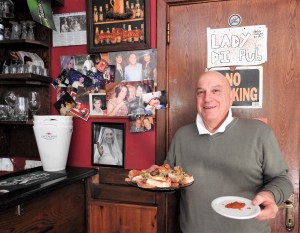 Cutajar got married when he was 18 and kept working at Las Vegas until it closed its doors.
Cutajar got married when he was 18 and kept working at Las Vegas until it closed its doors.“The British Forces’ departure from our islands drained all the energy from Strait Street, turning it into a shadow of what it was. Paceville became the new attraction for the younger generation while Valletta died out during the evenings. Eventually, Jimmy l-Irish, my older brother Harry and I acquired a bar in Melita Street and called it Pippo’s.”
“Later on, my brother and I also took over a business in Tignè Street, Sliema. This place was originally a bar known as Neriku and it was run by my grandfather and grandmother. After it served as an antique shop for some years, we decided to open it as a pub. Many of the visitors who came to Malta and stayed at the surrounding hotels in Sliema were British. So we had no doubts whatsoever about what we were going to name our new pub.”
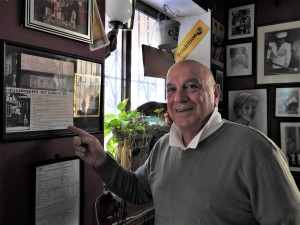 A framed copy of a newspaper feature which hangs on one of the walls narrates how the name Lady Di Pub came to life. Cutajar recounted this incident proudly.
A framed copy of a newspaper feature which hangs on one of the walls narrates how the name Lady Di Pub came to life. Cutajar recounted this incident proudly.“I was having a meal with a well-connected friend of mine at a London restaurant when he introduced me to Lady Diana. I told her that I would be naming a bar after her to record the memorable event of her marriage to Prince Charles. Shortly afterwards, I saw her again at a film premiere in Leicester Square and she reminded me about it.”
Lady Di Pub opened its doors right on Wednesday, 29 July 1981; the day of the eventful fairytale wedding.
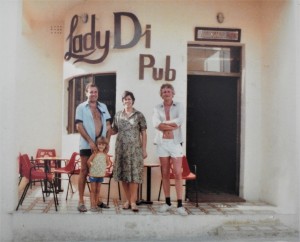 “This is how the pub looked at the time,” Cutajar said as he pointed at another old photo. “It consisted of just two small rooms. However, it had a very good clientele.”
“This is how the pub looked at the time,” Cutajar said as he pointed at another old photo. “It consisted of just two small rooms. However, it had a very good clientele.”Meanwhile, Pippo’s bar in Valletta was turned into Da Pippo’s restaurant and his brother Harry stayed to manage it. Frankie opted to run the pub in Sliema. In 2006, the Lady Di Pub was rebuilt after the property was earmarked for development and was demolished.
“Although the pub was new, I decided to recreate its old British soul. I knew that my clients would appreciate the warm feeling of a unique traditional corner huddled amongst the tall and modern buildings.”
In recent years, Sliema’s architectural context has changed considerably. Huge, inanimate buildings are replacing traditional stately homes, a small number of which still survive in Tignè Street.
“Times change and people have to move on with the progress which is generated. Sliema is not Valletta. Whereas Valletta is a historical city of culture, Sliema is a business hub and a touristic area. The more modernized it is, the more people it attracts, and the more customers will come to this pub,” Cutajar stated as he winked playfully.
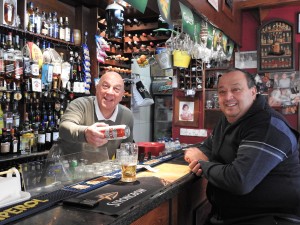 “His charismatic character and that of his son Keith who also works here are the secret of the success of this place,” revealed Ġanni Fenech, a regular client who was having a beer at the bar. “They have a way of making everyone feel welcome and they are also very good in the kitchen. The appetizers in this bar are always bountiful and delicious, urging you to keep on drinking so that the food continues to come out. Seasoned bread, pasta, ricotta and pea pies, cheesecakes… They simply taste like heaven with a glass of beer.”
“His charismatic character and that of his son Keith who also works here are the secret of the success of this place,” revealed Ġanni Fenech, a regular client who was having a beer at the bar. “They have a way of making everyone feel welcome and they are also very good in the kitchen. The appetizers in this bar are always bountiful and delicious, urging you to keep on drinking so that the food continues to come out. Seasoned bread, pasta, ricotta and pea pies, cheesecakes… They simply taste like heaven with a glass of beer.”Right on the point, Frankie came out of the kitchen with a plate of thickly sliced crusty Maltese bread spread with kunserva, a sweet tomato paste, and topped with olives, onions, lettuce and broad beans.
“Especially on Fridays and during weekends, Lady Di Pub is full of people and it stays open until the early morning hours. Some of our clients work in the nearby offices and come here to end the week in a good mood and meet friends. A number of others are regulars from Sliema including a small group of elderly people who have been gathering here each Sunday for the past 30 years! Other locals come from various areas around Malta. However, the majority of our clients are foreigners.”
Frankie starts his day at around 8:30am by doing errands, including buying fresh bread. After enjoying a coffee at a nearby coffee shop, he opens his pub at 10:00am. Soon, the first clients will come in and he starts preparing some inviting appetizers. By now, his long experience and a good knowledge of his clientele have furnished him with an invaluable insight of who will be calling at his pub on each day and what he will need to prepare.
 “We are here to make our clients feel comfortable. Should they wish to have lunch or dinner, we can cook anything to their liking, once they advise us beforehand. Last week, we cooked a selection of pasta, fried rabbit and rib-eye steak for a group, and they surely loved it!”
“We are here to make our clients feel comfortable. Should they wish to have lunch or dinner, we can cook anything to their liking, once they advise us beforehand. Last week, we cooked a selection of pasta, fried rabbit and rib-eye steak for a group, and they surely loved it!”Whilst the younger generation prefer to seek out Keith’s company, the older clientele feels closer to Frankie.
“I am 67 now but still going strong,” Frankie joked as he turned to a laptop and turned on some music. “Back in Valletta, we enjoyed live music at our nightclub. Until some years ago, I had a juke box here. Now I have to rely on this new technology. Flexibility is a must in such a business. Nowadays clients demand to hear particular songs while having a drink and this is the most practical way.”
Culture change is also evident in the choice of requested alcohol and in the clientele’s attitude.
“In the past, people preferred whisky especially Jack Daniels. We also served gin and vodka. Today, very few will ask for gin or vodka and the whisky which we sell is mainly J & B, Jameson, and Johnny Walker Black. Earlier generations used to come in and offer drinks to friends and to other people in the pub. We also had incidents when people got heavily drunk and still insisted to have more drinks. The present generation will generally order and pay for their own drinks, whether male or female. They are also more aware of the risks of over-drinking and they rarely get drunk.”
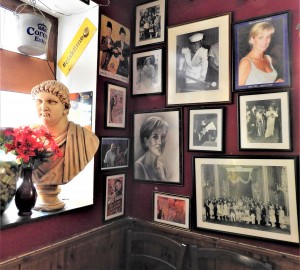 Several framed photos of Lady Diana keep a watchful eye over the pub’s customers.
Several framed photos of Lady Diana keep a watchful eye over the pub’s customers.“These were given to us by her photographer who became our friend,” Frankie explained. “Customers love to look at them especially now that she’s gone. She was very cherished by the people and they still miss her terribly.”
After her tragic death on 31 August 1997, Lady Diana’s fans were distraught. They frantically searched for anything which connected them to her.
“For a number of days after her demise, people left flowers at our doors as a sign of mourning. A British journalist for The People came to visit the pub and interviewed me about this experience. It was certainly a very disturbing loss but in this little corner in Malta, Lady Di’s memory is still very much alive.”
(This feature was published in SLIEMA TIMES – APRIL 2018 issued with The Times of Malta)
-
A sea of profits
A search through historical notarial deeds reveals how Maltese businesses exploited the cruel reality of war and slavery, maritime historian Dr Joan Abela tells Fiona Vella.
 “Even though there are people who might think that the human tragedy which we are experiencing today in the Mediterranean Sea may be something contemporary, in reality, the human element has always been an issue in this region,” Dr Joan Abela says as she refers me to some thick manuscripts that she had set aside at the Notarial Archives in Valletta.
“Even though there are people who might think that the human tragedy which we are experiencing today in the Mediterranean Sea may be something contemporary, in reality, the human element has always been an issue in this region,” Dr Joan Abela says as she refers me to some thick manuscripts that she had set aside at the Notarial Archives in Valletta.We had agreed to discuss the dreadful reality of slavery in the old days and these manuscripts are witness to this phenomenon which took place even in our islands.
“Before the Knights of St John came to Malta in 1530, the Maltese Islands were already involved in the enslavement business and this was quite a legitimate affair at the time. People captured as slaves or captives were considered as commodities and their negotiations were regarded as valuable transactions, which when necessary, were also recorded in notarial deeds.”
Dr Abela continued to inform me that in that era, the traffic of slaves occupied a prime place in the economic activity of maritime trade in the southern Mediterranean since it allowed the profitable exchange of monies and commodities.
“Well aware of the strategic geographical location of Malta in the slave trade business, the Knights of St John established a strong infrastructure in order to attract more merchants and agents. Those who stopped at our islands would have been able to replenish their ships and to make use of the excellent and accomodating financial services which included the availability of notaries, agents, and money changers. Indeed, Braudel stated that Malta together with Livorno acted as a central hub for the slave trade.”
One needed to have a special license to work as a corsair, otherwise he would be regarded as a pirate and could be hanged for capturing ships, cargo or people illegally.
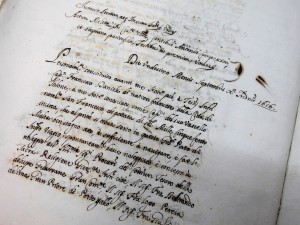 “Since corsairing could render ample returns, people invested in it and received their respective shares from the bounty that the corsairs brought with them after they seized a ship. Investors consisted mainly of businessmen and knights. However, one would also find the Jerosolimitan Nuns of the Sovereign Military Hospitaller Order of St John which were located in St Ursula Street, Valletta, forming part of these investors. Their share was due to them for their role in praying for the safe return of the corsairs.”
“Since corsairing could render ample returns, people invested in it and received their respective shares from the bounty that the corsairs brought with them after they seized a ship. Investors consisted mainly of businessmen and knights. However, one would also find the Jerosolimitan Nuns of the Sovereign Military Hospitaller Order of St John which were located in St Ursula Street, Valletta, forming part of these investors. Their share was due to them for their role in praying for the safe return of the corsairs.”As Dr Abela began to indicate various episodes from the displayed manuscripts, she admitted that she was often very touched by what she read in those pages.
“Obviously when one looks at history in a collective manner, one would say that there was this particular circumstance taking place during that period and that is it. Yet when one looks into these documents and starts reading a deed about an individual life, one starts empathizing with that person and many questions will come to mind. For example, I came upon a deed wherein a priest was selling a slave together with her son to a Genovese merchant on condition that the latter would baptise the child on that same day. The merchant agreed and the deal was made. When you read something like this, how can you help not wonder who this woman was and from where she had come?”
Corsairing was a high risk job but if all went well, those involved could become rich overnight.
“Men craved for the opportunity to become corsairs and at one point, there were so many men leaving their jobs to join corsair ships that the Maltese Universitas requested the King of Spain to restrain this because the island was at a loss with the local workforce.”
“Not all the captured ships delivered the same profits. A galley of the Sultan which would have been filled with riches and fine cloth, would be precious but not without issues and trouble. Other ships would be carrying worthy cargo such as sugar or wheat. Nonetheless, it was the human cargo which was considered the most profitable.”
Captured people could be sold as slaves or held as captives until they were ransomed.
“The whole process for redemption was very complicated. These contracts unravel all this system including how the involved parties went about to assure the best positive outcome from their deal. An agent would be requested to act as an intermediary between one party and the other, taking responsibility to collect a deposit from the captive and then to take him to an agreed destination in order to collect the rest of the money from his relatives and then release him.”
“In April 1558, a slave, Busert Bin Hahmet de Casar concluded the following agreement with his master Giuseppe Baldagno. Busert was transferred to Antonio de Banda from Messina who was a patrone of a ship belonging to Marco Antonio Delixandro, also from Messina. The ship was equipped to undertake a voyage to the Tripolitan fortress of Barbaria. Antonio was to conduct the slave to Tripoli, and from there retrieve 80 gold ducats which was the stipulated price for redemption. This amount was to be remitted either in their value in dinars or in oil, wool or leather goods which the Arabs sold inside the Tripolitan fortress, which goods would be exempt from duty. Busert promised to pay Giuseppe within twenty days of his arrival at the fortress, on condition that the patrone was not to let him disembark unless he received the said payment or its value in goods. Once arrived at destination, the slave would need to make the necessary connection with an intermediary in his own country who would be in a position to acquire the redemption money or goods for him. Once the sum was settled, the slave would become a free man, but if the sum was not paid, he was to return with the same ship and consigned back to his master Giuseppe.”
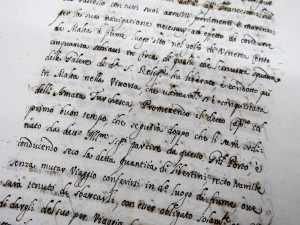 At times, the Grand Master had to issue a safe conduct certificate to enemy ships so that they might transfer the captives to the Tripoli port.
At times, the Grand Master had to issue a safe conduct certificate to enemy ships so that they might transfer the captives to the Tripoli port.“One such case was when Turgut Reis captured the ship Catharinet and took all her load to Djerba in 1548. Following this unfortunate capture for the Christian side, the Knight Augustino Spagno was sent as an envoy to negotiate redemption of the captives and once prices were fixed, a Muslim ship carrying these captives was to sail to the Order’s port in Tripoli.”
Interestingly, although being amid a Holy War against each other, this flourishing trade saw the collaboration and interaction between Christian and Muslim merchants.
“The capture of slaves did not only translate itself into financial rewards but acted also as a means to strengthen commercial ties between the various ethnic subjects of the cross and the crescent. Both Muslim and Christian merchants exploited this cruel reality and at times, this exploitation was so excessive that appeals were made to the local authorities to annul what plaintiffs described as usurious agreements which desperate souls had been forced to endorse in return for their freedom.”
“The Catholic Church strongly prohibited any compensation on loans, whether being related to business or not. Interest was regarded as usury and was not allowed. Often, this situation created shortages of cash money, especially after the Jewish community was expelled from the Maltese Islands in 1492. Nevertheless, there were numerous ways of circumventing this prohibition, such as through the difference quoted in the rate of exchange which would incorporate an agreed rate of interest or by paying the value in other goods.”
Besides ransom agents, there were also those agents who were summoned in order to make arrangements for the purchase of slaves to be delivered to Malta. Gender, age, ethnicity and price were agreed beforehand to eliminate any possible claims for additional payment.
“Although prices of slaves varied considerably, various studies indicate that the average selling price for a slave during the sixtenth century was in the region of 46 scudi. The acquisition of infidel slaves from Tripoli as a commodity for re-sale was one of the most profitable economic activities through which Malta registered a boom in her commerce.”
The arrival of Napoleon in 1798 abolished slavery in Malta and yet from litigation cases found in the Tribunal proceedings, during the early British Period, it is clear that the island’s association with slavery would not be terminated by a simple legislative enactment.
“And yet, back in the eighteenth century, people had already realized that the raiding system was over and that it was not feasible anymore. A new system based on lawful commerce and trade began to emerge; the Pinto stores being evidence of such change.”
(This article was published in the Family Business Supplement issued with The Times of Malta dated 24 February 2017)
-
Guests to history
One would probably spare only a few moments of consideration at the receipt of a wedding invitation. However, for Baron Igino de Piro d’Amico Inguanez, these endearing solicitations were cherished so much that he kept a collection of them, neatly separated according to their date and wrapped up together by a string.
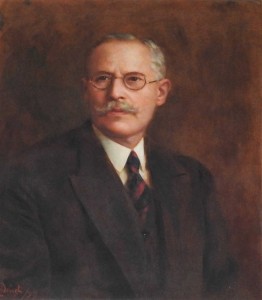 “Were it not for my grandfather’s interest to keep these wedding invitations, we would have lost this fascinating information which can be unravelled within each one of them,” remarked Marquis Nicholas de Piro as we walked towards an elegant table in one of the rooms at Casa Rocca Piccola where he had layed out a number of these invitations.
“Were it not for my grandfather’s interest to keep these wedding invitations, we would have lost this fascinating information which can be unravelled within each one of them,” remarked Marquis Nicholas de Piro as we walked towards an elegant table in one of the rooms at Casa Rocca Piccola where he had layed out a number of these invitations.I glanced out at the wide selection of wedding invitations tastefully set on the polished wooden surface, noticing the different sizes, shapes, writing, designs and paper. The earliest ones dated back to 1815, 1829 and 1832. They were quite plain and small, slightly bigger than a credit card, and written in Italian.
“Here are two of the prettiest ones” said the Marquis as he pulled them out of the rest.
These two invitations had been issued at the end of the 19th century. They were larger than the earlier ones and were quite different from each other. The one dated June 1896 was elegantly designed with an intricate cross at its corner and consisted of an invitation to the wedding between the noble Maria de Piro and Dr. Alfredo Stilon. The other one dated October 1899 was more colourful and rather than an invitation, it was more an announcement of the wedding which was to take place between the noble Maria Teresa de Piro and the Marquis Paolo Apap Bologna. Once again, both were written in Italian.
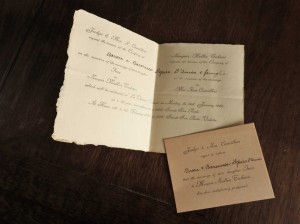 “Now look at this note which accompanies this wedding invitation,” said the Marquis as he handed it to me.
“Now look at this note which accompanies this wedding invitation,” said the Marquis as he handed it to me.The presentation of this wedding invitation was simpler than the previous two and the writing was in English. Here, Judge and Mrs L Camilleri were requesting the company of Baron and Baroness I de Piro d’Amico Inguanez and family to the wedding of their noble daughter Inez to Marquis Mallia Tabone on 26th January 1920. Yet this celebration was not destined to take place as a smaller card which was sent some days later informed those invited that this wedding had been indefinitely postponed.
 “From these invitations, one can also observe the traditional customs of the various eras. For example, this wedding invitation dated 1935 shows clearly that people who chose to get married during the period of Lent had to abide to some limitations.”
“From these invitations, one can also observe the traditional customs of the various eras. For example, this wedding invitation dated 1935 shows clearly that people who chose to get married during the period of Lent had to abide to some limitations.”Indeed, a formal note which was inserted together with the wedding invitation that was sent by Chev & Mrs E Moore and Mrs H Xuereb to announce the marriage of their daughter Alice Moore to Godfrey Xuereb, provided this information with direct instructions:
‘It is much regretted that in view of the restrictions imposed by Canon Law for weddings held in Lent, only a few guests may attend the religious ceremony at the Archbishop’s Palace.
You are therefore invited to meet the bride and bridegroom immediately after the ceremony at the residence at 4:00pm.’
 As we followed the different invitations that were sent along the years to Baron Igino and his family, we could also trace some of his friends and acquaintances, their residences, the chapels and churches where the marriages took place, and the selected locations for the wedding receptions. Although many of the churches still exist today, some of the street names had changed from Italian to English or were altered completely. A number of the residences mentioned have become quite renowned today whilst a few others were turned into commercial properties. Sadly, some of the lovely villas which provided exquisite entertainment in the bygone days were demolished to make place for large modern complexes.
As we followed the different invitations that were sent along the years to Baron Igino and his family, we could also trace some of his friends and acquaintances, their residences, the chapels and churches where the marriages took place, and the selected locations for the wedding receptions. Although many of the churches still exist today, some of the street names had changed from Italian to English or were altered completely. A number of the residences mentioned have become quite renowned today whilst a few others were turned into commercial properties. Sadly, some of the lovely villas which provided exquisite entertainment in the bygone days were demolished to make place for large modern complexes.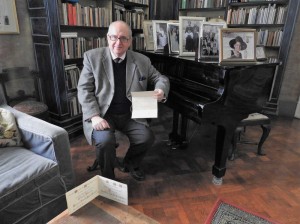 Amongst these, there was the wedding between Hilda Scicluna and Paymaster Lieutenant W Eric Brockman that took place on 4th March 1928. Their marriage was celebrated at the Archbishop’s Palace in Valletta which seems to have been quite a popular venue for such occasions. On the other hand, the reception was held at the bride’s parents residence that was located at 86 Strada Merkanti Valletta; a house which originally belonged to Sir Oliver Starkey, Bali of Aquila and Latin Secretary to Grand Master La Valette. Being an English Knight, he had assisted the Grand Master during the Great Siege of 1565 and was later given the privilege to be buried in the crypt of the Co-Cathedral of St John in Valletta, close to La Valette’s own burial place.
Amongst these, there was the wedding between Hilda Scicluna and Paymaster Lieutenant W Eric Brockman that took place on 4th March 1928. Their marriage was celebrated at the Archbishop’s Palace in Valletta which seems to have been quite a popular venue for such occasions. On the other hand, the reception was held at the bride’s parents residence that was located at 86 Strada Merkanti Valletta; a house which originally belonged to Sir Oliver Starkey, Bali of Aquila and Latin Secretary to Grand Master La Valette. Being an English Knight, he had assisted the Grand Master during the Great Siege of 1565 and was later given the privilege to be buried in the crypt of the Co-Cathedral of St John in Valletta, close to La Valette’s own burial place.The Cathedral in Mdina seems to have been another prominent place for marriages. On 24th January 1937, Adelina Maempel was married to Edwin England Sant Fournier. A reception followed at Villa Luginsland in 26 Boschetto Road, Rabat; a lovely villa which was built by Baron Max von Tucker, the German consul who was serving in Malta in the early 20th century. Unfortunately in recent years years, this remarkable place was in an abandoned state and had a haunting atmosphere.
 The only wedding invitation which came from Gozo looked quite distinguished and it boasted a silver wax seal. The marriage of Carmela and Paul Vella took place on 4th August 1937 and their reception was organized at the Duke of Ediburgh Hotel in Victoria, Gozo. Alas, in recent years, this splendid hotel that was beautifully constructed in Victorian architecture was demolished in order to make way for a commercial centre and a number of residential units.
The only wedding invitation which came from Gozo looked quite distinguished and it boasted a silver wax seal. The marriage of Carmela and Paul Vella took place on 4th August 1937 and their reception was organized at the Duke of Ediburgh Hotel in Victoria, Gozo. Alas, in recent years, this splendid hotel that was beautifully constructed in Victorian architecture was demolished in order to make way for a commercial centre and a number of residential units.“As you have already noted, some of these wedding invitations pertained to our relatives. Incidentally, this one which announces the marriage between my aunt Mona de Piro to Major John E J Nelson on 28th December 1940 is a favourite of mine, particularly because she was quite a character and she kept her high spirits even when she was aged more than ninety. Well, she’s there, looking at us!” the Marquis exclaimed as he pointed to a delightful portrait on the opposite wall.
My eyes met with those of a young, graceful girl, defiantly posing with an off-the-shoulder silver dress which melted in the greyish background behind her.
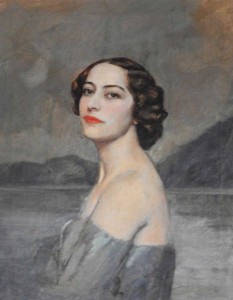 “That portrait created much talk when her relatives saw it since it was regarded too sensual at the time. It was commissioned by her Italian boyfriend, Marquis Onofrio Bartolini Salinbeni, and the painting was done by Arthur Acton who lived in a palace in Florence. Onofrio was madly in love with Mona but unfortunately, their relationship ended and when she returned to Malta, a relative of hers went to Italy to claim this painting since it was not deemed fit for him to keep it,” smiled the Marquis as he went to add some logs to the fire burning in the stylish hearth besides us.
“That portrait created much talk when her relatives saw it since it was regarded too sensual at the time. It was commissioned by her Italian boyfriend, Marquis Onofrio Bartolini Salinbeni, and the painting was done by Arthur Acton who lived in a palace in Florence. Onofrio was madly in love with Mona but unfortunately, their relationship ended and when she returned to Malta, a relative of hers went to Italy to claim this painting since it was not deemed fit for him to keep it,” smiled the Marquis as he went to add some logs to the fire burning in the stylish hearth besides us.A warm gush of air embraced the room as the logs protested and cracked and poured a glowing light over the wedding invitations lying in front of us. For a short spell, I thought that I could hear the tinkling of the glasses filled with red velvety wine and golden sizzling champagne as the guests toasted to the newly married couples.
(This article was published in the Weddings Supplement issued with The Sunday Times of Malta dated 13th March 2016)
-
To die for a piece of bread
Although Carnival is generally associated with fun, exuberance and colour, it was sadness, tragedy and darkness which marked this festive season on 11th February 1823, after more than a hundred children died in Valletta. Details of this terrible tragedy are immortalized in black and white in the Malta Government Gazette of Friday, 14th February 1823 which is archived at the National Library of Malta in Valletta.
Initially, news of this tragedy was recorded as a Government Notice in the Malta Government Gazette (No. 557) by Richard Plasket, Chief Secretary to Government, wherein he declared that an investigation was taking place in order to obtain any possible evidence regarding this fatal accident. A published report of these findings was later annexed as a Supplement (pp. 3391-2) to the same journal of 14th February 1823.
In this long report, Plasket includes information that was provided to him by the Archbishop of Malta, persons examined before the Magistrates of Police which comprised both relatives of the victims and other individuals who were present during this incident, and also a medical report related to this case.
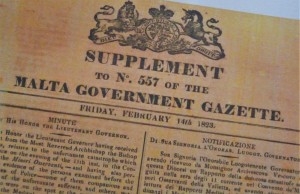 At the beginning of this statement, he furnishes a context for this mishap wherein he mentions that in those years, during the last days of the Carnival celebrations, it had become a tradition to gather a group of boys aged from 8 to 15, who came from the lower classes of Valletta and the Three Cities, to participate in a particular activity. In this event, children who opted to join were taken in a procession to Floriana or elsewhere, and after attending mass, they received some bread which was financed by the Government and other beneficiaries. The main aim of this activity was to protect the children by keeping them out of the riot and confusion of the Carnival that took place in the streets of these cities. The arrangement of this procession was under the responsibility of the Ecclesiastical Directors who taught Cathecism.
At the beginning of this statement, he furnishes a context for this mishap wherein he mentions that in those years, during the last days of the Carnival celebrations, it had become a tradition to gather a group of boys aged from 8 to 15, who came from the lower classes of Valletta and the Three Cities, to participate in a particular activity. In this event, children who opted to join were taken in a procession to Floriana or elsewhere, and after attending mass, they received some bread which was financed by the Government and other beneficiaries. The main aim of this activity was to protect the children by keeping them out of the riot and confusion of the Carnival that took place in the streets of these cities. The arrangement of this procession was under the responsibility of the Ecclesiastical Directors who taught Cathecism.Indeed, according to this tradition, on the 10th February 1823, some children were taken to attend mass at Floriana and were then accompanied to the Convent of the Minori Osservanti in Valletta (today known as the Convent of the Franciscans of St Mary of Jesus or Ta’ Ġieżu) where they were given bread without any difficulty or trouble. The same ritual was intended to take place the day after. Yet no one had any idea that a series of errors would eventually lead to such a great tragedy.
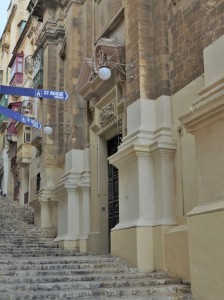 Everything started according to plan on 11th February 1823. The children were gathered in a group and were taken to mass at Floriana. However, when the ceremony lasted an hour longer than usual, the children’s procession to the Convent in Valletta coincided with the end of the Carnival celebrations, when a great number of jubilant people were returning home. This led to the next blunder, as a number of adults and children who were passing by and who knew of this tradition, secretely mixed in with the other boys in order to share the bread which would be distributed.
Everything started according to plan on 11th February 1823. The children were gathered in a group and were taken to mass at Floriana. However, when the ceremony lasted an hour longer than usual, the children’s procession to the Convent in Valletta coincided with the end of the Carnival celebrations, when a great number of jubilant people were returning home. This led to the next blunder, as a number of adults and children who were passing by and who knew of this tradition, secretely mixed in with the other boys in order to share the bread which would be distributed.In line with the usual arrangement, these boys were to enter into a corridor of the Convent from the door of the vestry of the Church, and were to be let out through the opposite door of the Convent in St Ursula Street, where the bread was to be distributed. In order to prevent the boys who received their share from reentering to take a second helping of bread, it became customary to lock the door of the vestry. Yet this time, since the children were late, this door was left open for a longer time so that they could enter. As the sun was setting and darkness crept in, nobody realized that other men and boys who did not form part of the original group were entering too.
Soon, the boys who were queuing in the corridor found themselves being pushed by these trespassers as they forced themselves in. The situation worsened when eventually the vestry door was closed as usual and the children were shoved further at the end of the corridor where a door stood half open so that no one could get back in a second time.
That day was certainly ill-fated when further mistakes continued to occur. In fact, a lamp which was usually lit in the corridor was somehow put out, leaving the overcrowded area in total darkness. This confused the people even more and as they tried to push themselves forward in order to get out, the boys who were at the front fell down a flight of eight steps on top of each other, thereby blocking further the door which happenned to open inwards.
Suddenly, both those who were distributing the bread and the Convent’s neighbours began to hear children shrieking out. They ran to give their assistance but a lot of time was wasted as they tried to open the two doors which led to the corridor in order to reach the people inside.
Eventually, many children were taken out fainting but recovered soon. Others appeared lifeless but were brought to their senses some time afterwards. Regretfully, 110 boys from 8 to 15 years of age perished from suffocation when they were pressed together in such a small place or because they were trampled upon.
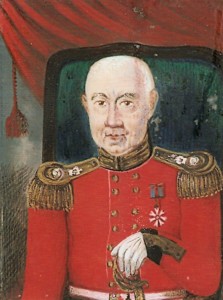 After investigating this accident, the Lieutenant Governor concluded that this was an unfortunate accident caused by the succession of errors mentioned above. Consequently, no one was accused for the death of these children since these acts were not done on purpose to harm them. In fact, Plasket commented that everyone had collaborated to assist these poor boys and even the victims’ relatives had allowed the police and the soldiers to work speedily and diligently in order to save as many children as possible. He insisted that were it not for this, the tragedy could have been much worse.
After investigating this accident, the Lieutenant Governor concluded that this was an unfortunate accident caused by the succession of errors mentioned above. Consequently, no one was accused for the death of these children since these acts were not done on purpose to harm them. In fact, Plasket commented that everyone had collaborated to assist these poor boys and even the victims’ relatives had allowed the police and the soldiers to work speedily and diligently in order to save as many children as possible. He insisted that were it not for this, the tragedy could have been much worse.As I followed further this narrative by focusing on the names mentioned in Plasket’s report, I succeeded to trace the Captain of the Malta Fencibles who led the soldiers during this tragic moment. It was his descendant, Marquis Nicholas De Piro who led me to see Colonel Marquis Giuseppe De Piro’s portrait which is located at Casa Rocca Piccola in Valletta.
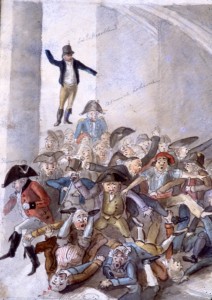 An interesting discussion ensued between us during which the present Marquis informed me also about General Sir George Whitmore who headed the Royal Engineers’ detachment on Malta as its Colonel Commandant between 1811 and 1829. Whitmore had written about his experiences in Malta and had also produced some illustrations related to our islands. Interestingly, Marquis Nicholas De Piro was in possession of a copy of one of these ancient illustrations in the form of a very small slide, which showed some individuals being trampled upon by a group of other people. He wondered whether this slide could be portraying this misfortunate accident of the Carnival of 1823. Yet no children are included in this representation and so it is not clear whether it actually depicts this narrative.
An interesting discussion ensued between us during which the present Marquis informed me also about General Sir George Whitmore who headed the Royal Engineers’ detachment on Malta as its Colonel Commandant between 1811 and 1829. Whitmore had written about his experiences in Malta and had also produced some illustrations related to our islands. Interestingly, Marquis Nicholas De Piro was in possession of a copy of one of these ancient illustrations in the form of a very small slide, which showed some individuals being trampled upon by a group of other people. He wondered whether this slide could be portraying this misfortunate accident of the Carnival of 1823. Yet no children are included in this representation and so it is not clear whether it actually depicts this narrative.My research ended at Ta’ Ġieżu Church and I watched in silence the area where these children lost their lives. Sadness engulfed me when I climbed up the steps on my way back while pondering how these children could end in this way for a piece of bread.
(This article was published in the Carnival Supplement issued with the Times of Malta dated 3rd February 2016)
-
IF THESE WALLS COULD TALK
450 years ago, the Maltese Islands were in the spotlight of several European sovereigns after they had succeeded to come out victorious from the massive siege that was laid upon them by the powerful Ottoman Empire. Fort St Elmo lay in ruins and the other fortifications and houses which had been targeted by the enemy were in no better shape. The land still seeped in the blood of the thousands who had lost their lives during the fighting, whilst many others remained maimed.
Amid this devastation, the eminence of the surviving Knights of the Order of St John surged, and their fame reached legendary proportions. Letters of congratulations which they received from all over Europe, uplifted their spirits, whilst generous donations eventually helped them to build the new city of Valletta.
The Knights of St John continued to rule the Maltese Islands until 1798, when they were ousted by French Military General, Napoleon Bonaparte. Although, some might believe that at this time, the Order was obliterated, in reality, these mythical Hospitallers are still present amongst us, and are as real as ever.
The Russian Grand Priory of Malta
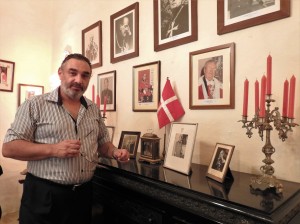 Since the early years of the Hospitallers’ foundation by Blessed Gerard, the Order protected the faithful and provided aid to the sick and poor. These elements have always remained deeply rooted in the mission of the knights who followed throughout the centuries.
Since the early years of the Hospitallers’ foundation by Blessed Gerard, the Order protected the faithful and provided aid to the sick and poor. These elements have always remained deeply rooted in the mission of the knights who followed throughout the centuries.“Even today, as Knights and Dames of the Russian Grand Priory of Malta who form part of the Order of St John of Jerusalem, Knights Hospitallers, under the constitution of the late King Peter II of Yugoslavia, we strive to continue to live up to our motto “Pro Fide, Pro Utilitate Hominum,” declared Chev. Saviour Garcia as we stood in front of a large painting of Blessed Gerard at Palazzino Sapienti in Valletta.
“Today, the Order’s mission still incorporates the duty to profess the Christian faith. However, its present members are not fighters but humanitarians who swear to act for the common good of all people without distinction of race or religion.”
Garcia outlined a number of philantropic projects which the Russian Grand Priory of Malta have been taking care of without much pomposity. Amongst these he mentioned St Joseph’s Residential Home for children in Żabbar, Dar Nazareth’s Residential Home for people with disability in Żejtun, and the construction of a hospital and a hostel in Thailand which caters for the needs of dying children with AIDS.
“The first investiture and the official institution of The Malta Priory took place on March 8, 1964. A few days after, His Majesty King Peter II of Yugoslavia legitimized the Order by giving it a new Constitution to meet 20th century demands. Within the first decades of its existence, The Malta Priory made several notable achievements which ultimately led it to be elevated to Grand Priory by Royal Warrant from King Peter II on Feb 22, 1970. This Royal Warrant gave our Grand Priory the name of Russian Grand Priory of Malta.”
Palazzino Sapienti, Valletta
 Interestingly, it was the same king who donated the sum of 1000 dollars in order to open a fund for the purchase of a large house which was expected to serve as the World Head Quarters of this Order. The choice fell on the prestigious Palazzino Sapienti which today is located at 223, St Paul Street, Valletta, right opposite to the University of Malta Valletta Campus.
Interestingly, it was the same king who donated the sum of 1000 dollars in order to open a fund for the purchase of a large house which was expected to serve as the World Head Quarters of this Order. The choice fell on the prestigious Palazzino Sapienti which today is located at 223, St Paul Street, Valletta, right opposite to the University of Malta Valletta Campus.An original letter held at the archives of Palazzino Sapienti that was sent to Czar Paul I by Grand Master Hompesch in 1797, indicates that at the time, the Russians had an interest to involve themselves in the Order. That is why, after the Knights of St John were expelled from Malta, some of them opted to find refuge in St Petersburg, where they elected the Russian Emperor, Paul I, as their Grand Master, thereby replacing Ferdinand von Hompesch who was then held in disgrace and had to abdicate in 1799.
Prior to its present distinguished function, Palazzino Sapienti had its fair share of interesting history.
“Whilst researching about the origins of this building, I discovered that its construction was commissioned in the late 16th century by the English Grand Prior of the Order of St. John, Sir Richard Shelley. However, he did not have the opportunity to enjoy his residence for long, since he got into disagreement with the Inquisitor after he failed to present to him his correspondence to the Protestant Queen Elizabeth for censorship, as was the regulation at the time. Soon, matters got worse when Shelley had also a dispute with Grand Master Peter del Monte, and in a diplomatic way, this building was taken away from him after he was offered another property. Instead, Palazzino Sapienti became the residence of Fra Nicolo Sollima, the Collegium Melitense Rector,” revealed Garcia.
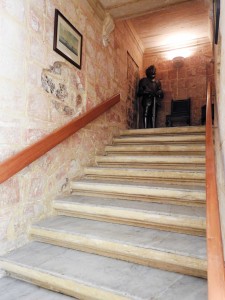 “Stone used for the building of the house was quarried on site. Once the building was complete, the resultant small quarry was used as a water cistern and basement. This process of cutting stones directly from Monte Sciberras hurried the process of the building of the new city.”
“Stone used for the building of the house was quarried on site. Once the building was complete, the resultant small quarry was used as a water cistern and basement. This process of cutting stones directly from Monte Sciberras hurried the process of the building of the new city.”“The facade of the palazzino was imposing, having a main door flanked by two others. The main entrance was decorated by a barrel vaulted ceiling, typical of the 16th century. Traces of a blocked arch located under the staircase which leads up to the piano nobile points out that originally, the level of the street was lower than it is today.”
“On 12th September 1634, a gunpowder magazine located in the whereabouts of the palazzino, blew up, killing 33 persons. The devastated site was left abandoned for thirty years until Grand Master Nicholas Cotoner established the Fondazione Cotoner in order to rebuild the houses in Strada San Paolo. The palazzino had suffered some cracks in the walls and its glass windows were shattered. Some structural changes were done to it, however, this structure was never intended to be built higher than two floors, since it would have been higher than the opposite building and would have cast a shadow on the University’s sundial.”
“Traces of red paint on the walls show that this building was painted in this colour. Meanwhile, the limestone balcony supports, the internal courtyard and the main staircase were adorned with seashell carvings that represented St John the Baptist, the patron saint of the Order of St. John. The seashell is also representative of the water element, in this case creativity and knowledge, as befits the University Rector’s house.”
It was a pleasure to explore this palazzino which I had never visited before. In the meantime, Garcia recounted some curiosities about the notable tenents who lived there.
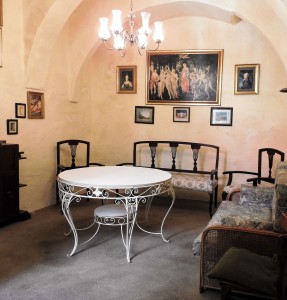 “In 1919, the tenant of Palazzino Sapienti was the lawyer Luigi Camilleri. On 7th June, 1919, Prince Lobanov-Rostovsky and Count Andrey Bobrinsky, both Russian Imperial refugees, were visiting Camilleri at his residence when suddenly the ‘Sette Guigno’ riots broke out. A large crowd made its way to the Royal Malta University and started to attack it, tearing down the English Imperial flag. These two Russian nobles who were witnessing this from the opposite palazzino were scared stiff since the remembrance of the Bolshevik revolution still haunted them. They stayed at the premises till the 12th June when they were escorted back to San Anton Palace in Balzan by Police Superintendent James Frendo Cumbo.”
“In 1919, the tenant of Palazzino Sapienti was the lawyer Luigi Camilleri. On 7th June, 1919, Prince Lobanov-Rostovsky and Count Andrey Bobrinsky, both Russian Imperial refugees, were visiting Camilleri at his residence when suddenly the ‘Sette Guigno’ riots broke out. A large crowd made its way to the Royal Malta University and started to attack it, tearing down the English Imperial flag. These two Russian nobles who were witnessing this from the opposite palazzino were scared stiff since the remembrance of the Bolshevik revolution still haunted them. They stayed at the premises till the 12th June when they were escorted back to San Anton Palace in Balzan by Police Superintendent James Frendo Cumbo.”“During the Second World War, the premises were used by the British Royal Air Force for the decoding of enemy aerial operations. Palazzino Sapienti survived two enemy bombs which were dropped in the vicinity. Yet tragedy still struck this place when two children, who were attending school in this building after the Valletta school was hit, found their way down a spiral staircase which led to the city’s undergrounds and got lost there. No one ever found them and these stairs have been blocked ever since.”
 Today, this building is also proud to possess three saint reliquaries: a first degree bone fragment from the Order’s Patron Saint St. John the Baptist, and two third degree relics in the form of a throne chair on which St. John Paul II sat during one of his Papal visits to Italy, and a hand signed dedication by Sister Mother Theresa of Calcutta who was also a member of the Order.
Today, this building is also proud to possess three saint reliquaries: a first degree bone fragment from the Order’s Patron Saint St. John the Baptist, and two third degree relics in the form of a throne chair on which St. John Paul II sat during one of his Papal visits to Italy, and a hand signed dedication by Sister Mother Theresa of Calcutta who was also a member of the Order.“Besides housing the Seat of the Order of St John of Jerusalem, Knight Hospitaller, Palazzino Sapienti has now opened its doors to the public who might be interested to visit it. Moreover lectures regarding various subjects are organized inside one of its rooms wherein we are also giving the opportunity to university students who would like to present talks about their studies or thesis.”
Certainly, an invitation to such a prestigious, architectural, and historical gem, should not be missed.
(This article was published in ‘Focus Valletta’ Suppliment issued with The Times of Malta dated 30 September 2015)
-
Djarju ta’ poeta, suldat fl-Assedju l-Kbir
450 sena ilu, Malta kienet għaddejjha minn wieħed mill-agħar perjodi fl-istorja tagħha, hekk kif din ġiet attakkata minn armata kbira Torka li kienet ħalfet li se teqred lill-Ordni tal-Kavallieri ta’ San Ġwann minn wiċċ id-dinja. It-Torok ma kellhom l-ebda dubju li dil-gżira ċkejkna kienet ser tiġi f’idejhom f’qasir żmien u waqt bosta mumenti, anki l-kavallieri għaddielhom minn moħħhom l-istess ħsieb. Imma wara assedju kbir li ħalla warajh mijiet ta’ mejtin u midruba, fosthom lill-magħruf Dragut, Malta, il-Maltin u l-kavallieri, irnexxielhom joħorġu rebbieħa u t-Torok ġew f’sitwazzjoni fejn kellhom jirtiraw b’mod immedjat.
Affreski li juru xeni mill-assedju tal-1565
Fatt interessanti huwa illi l-aktar episodji sinifikanti li seħħu waqt dan l-assedju ġew impinġija mill-artist Taljan, Matteo Perez d’Aleccio. Huwa ġie kkummissjonat jagħmel dax-xogħol minn Fra Jean l’Evesque de La Cassiere, li kien il-Gran Mastru ta’ Malta bejn is-snin 1572 u l-1581. Is-sett ta’ affreski tal-Assedju l-Kbir tal-1565 kellu l-għan li jikkommemora dawn il-ġrajjiet tremendi imma erojċi li kienu ġraw xi ftit tas-snin qabel. M’hemmx xi ngħidu, rebħa monumentali bħal dik li kisbu l-kavallieri f’pajjiżna, kienet ġibdet ir-rispett u l-ammirazzjoni ta’ bosta pajjiżi, tant li l-Ordni mhux talli reġgħet ġiet fuq saqajha imma saret akbar milli qatt kienet qabel. Illum dawn l-affreski jinsabu ġewwa waħda mis-swali tal-Palazz tal-Gran Mastru fil-Belt Valletta u huma xhieda ta’ dak li għadda minnu pajjiżna fis-sena 1565.
It-taqtiegħa bejn l-Ordni u t-Torok
 Għal mijiet ta’ snin, il-Kavallieri ta’ San Ġwann u l-Ottomani kienu mqabbdin f’xulxin kemm fuq kwistjoni ta’ reliġjon u anki minħabba l-għatx li kellhom għall-poter sabiex jakkwistaw l-artijiet.
Għal mijiet ta’ snin, il-Kavallieri ta’ San Ġwann u l-Ottomani kienu mqabbdin f’xulxin kemm fuq kwistjoni ta’ reliġjon u anki minħabba l-għatx li kellhom għall-poter sabiex jakkwistaw l-artijiet.Għalkemm oriġinarjament, l-Ordni kellha l-funzjoni li tilqa’ u tieħu ħsieb il-pellegrini li kienu jaslu f’Ġerusalemm, maż-żmien din evolviet natura militari sabiex tiddefendi b’mod attiv il-pellegrini u r-reliġjon Kristjana. Naturalment, dan l-aġir tal-kavallieri, ma damx ma daħħalhom f’taqtiegħat mal-Musulmani, u aktar ma għaddew is-snin, dan il-ġlied beda jiżdied fil-feroċità tiegħu.
Hekk kif l-Ordni bdiet tikseb is-simpatija tan-nobbli, tar-rejiet u tal-Papiet, din bdiet tiġbed lejha wkoll bosta donazzjonijiet ta’ flus, rikkezzi, artijiet u privileġġi. B’hekk beda jikber ukoll il-poter tal-membri tagħha u dan wassal biex attira diversi tfal tan-nobbli li bdew jieħdu l-voti sabiex isiru kavallieri.
L-Ordni ta’ San Ġwann f’Rodi
L-Ordni tal-Kavallieri ta’ San Ġwann damet f’Ġerusalemm sal-1187, sakemm finalment, din il-belt waqgħet taħt il-kmand tas-Sultan Saladin. B’hekk il-kavallieri kellhom jibdlu l-kwartieri tagħhom u jimxu lejn Margat fis-Sirja, imbagħad f’Acre fi Tripli u eventwalment f’Limassol f’Ċipru. Madanakollu, x-xewqa tal-kavallieri kienet li jirnexxielhom jakkwistaw il-gżira ta’ Rodi, u fl-1309, huma rebħuha mingħand il-Biżantini.
Il-kavallieri ma damux ma għarfu u sarrfu l-kwalitajiet ta’ Rodi li kienet gżira b’pożizzjoni tassew strateġika hekk kif din kienet tgħaqqad id-dinja tal-Lvant ma’ dik tal-Punent. Huma bidlu lil din il-lokalità f’belt iffortifikata u maż-żmien, bnew flotta liema bħalha li bdiet tattakka b’mod regolari x-xwieni tal-Ottomani. Iżda dan ma kienx biżżejjed għall-kilba tal-poter u l-flus għax apparti x-xwieni, l-Ordni bdiet taħbat ukoll għal xi bliet u kastelli Ottomani, sakemm finalment, it-Torok ġew urtati mhux ħażin.
Il-kavallieri kienu saru xewka tweġġa’ ħafna qalb l-imperu Ottoman u t-Torok ma tħallew bl-ebda għażla ħlief li jaraw kif se jsibulhom tarfhom. Huma attakkaw lil Rodi għal diversi drabi imma qatt ma rnexxielhom iġibuha żewġ. Sakemm finalment, fl-1522, Sultan Suleiman ħa r-riedni f’idejh u ma qgħadx bi kwietu qabel niżżel il-kavallieri għarkubbtejhom wara sitt xhur ta’ kumbattimenti. Fuq deċiżjoni tal-istess sultan, l-Ordni tħalliet titlaq minn Rodi b’mod ċivili u dakinhar anki numru ta’ nies minn Rodi ngħataw il-libertà li jsegwuhom. Ftit kien jaf Suleiman, kemm xi snin wara, huwa kien ser jiddispjaċih bil-kbir talli wera tant irġulija mal-kavallieri.
Il-Kavallieri jsibu ruħhom Malta
Infatti, wara li l-kavallieri għamlu sebgħa snin iterrqu u jsalpaw minn art għall-oħra, mingħajr l-ebda post li setgħu isejjħulha darhom, huma ġew mogħtija l-gżejjer tagħna mill-Imperatur Charles V. Kien l-14 t’Ottubru 1530 meta huma middew l-ewwel passi tagħhom fuq l-art li eventwalment kellha tifforma parti tant importanti mill-istorja tal-Ordni.
Anki Malta nzertat li kellha pożizzjoni ġeografika sinifikattiva ħafna bħal dik ta’ Rodi, hekk kif din kienet tinsab f’nofs il-Mediterran bejn l-Ewropa u l-Afrika. Naturalment, il-kavallieri ma damux ma bnew fuq dan il-potenzjal sabiex jibdlu lil Malta f’fortizza. Filwaqt li n-nobbli ta’ Malta kienu jgħixu fl-Imdina, il-kavallieri ppreferew jistabilixxu ruħhom il-Birgu, l-aktar minħabba l-viċinanza tal-baħar. Dak iż-żmien, il-Birgu kien jikkonsisti biss f’raħal ċkejken tas-sajjieda li kellu kastell antik. Imma l-paġna ta’ dan il-post ma damitx ma nqalbet ta’ taħt fuq meta l-kavallieri bdew jibnu l-palazzi tagħhom u l-parroċċa tal-Birgu nbidlet fil-Knisja Konventwali tal-Ordni.
It-Torok jaħilfu li jeqirdu l-Ordni darba għal dejjem
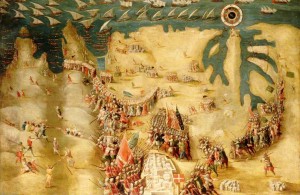 Fi ftit tas-snin, l-Ordni reġgħet issaħħet u l-qawwa tal-flotta tagħha bdiet tintuża biex mill-ġdid tattakka x-xwieni tal-Ottomani li kienu jsalpaw fl-ibħra tal-qrib. Il-ġarra ġejja u sejra fl-aħħar tinkiser u l-istorja rrepetiet ruħha, hekk kif mill-ġdid, it-Torok daħħluha f’rashom li jrażżnu lill-Ordni – issa, darba għal dejjem.
Fi ftit tas-snin, l-Ordni reġgħet issaħħet u l-qawwa tal-flotta tagħha bdiet tintuża biex mill-ġdid tattakka x-xwieni tal-Ottomani li kienu jsalpaw fl-ibħra tal-qrib. Il-ġarra ġejja u sejra fl-aħħar tinkiser u l-istorja rrepetiet ruħha, hekk kif mill-ġdid, it-Torok daħħluha f’rashom li jrażżnu lill-Ordni – issa, darba għal dejjem.Il-kavallieri kienu ilhom jisimgħu mingħand l-ispiji tagħhom li l-Ottomani kienu qed jippjanaw attakk kbir għal fuq Malta u min-naħa tagħhom, huma bdew jippruvaw jagħmlu dak kollu li jistgħu biex jippreparaw il-gżira sabiex tilqa’ għal dan l-assedju. Madanakollu, hekk kif il-kavallieri sabu l-flotta massiċċa tat-Torok ma’ wiċċhom fl-għodwa tat-18 ta’ Mejju tal-1565, huma baqgħu bla kliem.
Poeta jikteb djarju waqt li qed jieħu sehem fl-assedju
Minn hemm bdew il-battalji ħorox bejn il-kavallieri u l-Ottomani li damu għaddejjin sa erbgħa xhur wara. Fatt kurjuż huwa illi fost is-suldati li kienu qed jipparteċipaw f’dan l-assedju flimkien mal-Ordni, kien hemm ukoll min niżżel xi noti dwar dak li kien qed iseħħ.
Fost dawn, kien hemm Francesco Balbi di Correggio, poeta li kien jikteb bit-Taljan u bl-Ispanjol. Waqt l-assedju, huwa kellu 60 sena, u kien għażel li jservi bħala suldat minħabba li kien qed jgħix f’povertà kbira. Ta’ kittieb li kien, waqt dawn it-taqtiegħat storiċi, huwa żamm djarju fejn kważi ġurnata b’ġurnata jirrakkonta d-dettalji ta’ dak li għaddew minnu hu, sħabu u l-bqija tal-kavallieri, l-Maltin u t-Torok. Meta l-assedju spiċċa, huwa ra kif għamel biex ippubblika d-djarju tiegħu u llum xogħolu huwa meqjus bħala wirt storiku importanti ferm.
Bis-saħħa ta’ Balbi, illum, wara 450 sena, aħna nistgħu nsegwu pass pass kif żvolġa dan l-avveniment, kif ittieħdu d-deċiżjonijiet, l-iżbalji u l-istrateġiji effettivi li seħħu u diversi esperjenzi oħra.
Blog ta’ Heritage Malta dwar l-Assedju l-Kbir
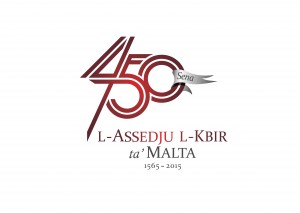 Sabiex taqsam dawn il-ġrajjiet interessanti mal-pubbliku, hekk kif dis-sena qed jiġi kkommemorat l-450 anniversarju mill-Assedju l-Kbir, Heritage Malta organizzat blog elettroniku fejn wieħed jista’ jaqra silta kuljum tal-aħbarijiet li jkunu ġraw f’dik il-ġurnata partikolari. F’dan il-blog, ma jonqsux ukoll xi fatti mhux tas-soltu u oħrajn kemmxejn kurjużi. Fl-istess blog, il-pubbliku se jkun jista’ jiskopri wkoll informazzjoni dwar numru ta’ oġġetti relatati mal-Assedju l-Kbir li bejn l-4 ta’ Settembru u s-6 ta’ Diċembru 2015, se jkunu qed jiffurmaw parti minn esebizzjoni internazzjonali li se tittella’ minn Heritage Malta fil-Kmamar Statali tal-Palazz tal-Gran Mastru l-Belt. Barra minn hekk, il-qarrejja ta’ dan il-blog se jkunu wkoll infurmati dwar id-diversi attivitajiet oħra relatati ma’ dan il-perjodu storiku li ser ikun qed jittellgħu minn żmien għall-ieħor.
Sabiex taqsam dawn il-ġrajjiet interessanti mal-pubbliku, hekk kif dis-sena qed jiġi kkommemorat l-450 anniversarju mill-Assedju l-Kbir, Heritage Malta organizzat blog elettroniku fejn wieħed jista’ jaqra silta kuljum tal-aħbarijiet li jkunu ġraw f’dik il-ġurnata partikolari. F’dan il-blog, ma jonqsux ukoll xi fatti mhux tas-soltu u oħrajn kemmxejn kurjużi. Fl-istess blog, il-pubbliku se jkun jista’ jiskopri wkoll informazzjoni dwar numru ta’ oġġetti relatati mal-Assedju l-Kbir li bejn l-4 ta’ Settembru u s-6 ta’ Diċembru 2015, se jkunu qed jiffurmaw parti minn esebizzjoni internazzjonali li se tittella’ minn Heritage Malta fil-Kmamar Statali tal-Palazz tal-Gran Mastru l-Belt. Barra minn hekk, il-qarrejja ta’ dan il-blog se jkunu wkoll infurmati dwar id-diversi attivitajiet oħra relatati ma’ dan il-perjodu storiku li ser ikun qed jittellgħu minn żmien għall-ieħor.Waħda min dawn l-attivitajiet li ġġib l-isem 1565:First and Last Hope se tiġi organizzata fil-Forti Sant’Iermu bejn is-26 u t-28 ta’ Ġunju 2015. Hawnhekk, diversi atturi popolari Maltin ser ikunu qed jagħtu l-ħajja mill-ġdid lil uħud mill-avvenimenti li seħħu waqt l-assedju, filwaqt li jinvolvu anki lill-pubbliku preżenti.
Il-blog tal-assedju qiegħed jinkludi wkoll xi filmati relatati ma’ dan iż-żmien. Intant, bħalissa, wieħed jista’ jsegwi filmat qasir li jirrakkonta d-destin kiefer tal-Kappella ta’ Sant’Anna li tinsab fil-Forti Sant’Iermu.
Il-poplu Malti qed jiġi mħeġġeġ isegwi dan il-blog sabiex jagħraf dak li għaddew minnu missirijietna u b’hekk japprezza aktar il-ħila ta’ niesna, il-kapaċità militari tal-Ordni, l-istorja tal-fortifikazzjonijiet u mitt ħaġa oħra. Fl-istess ħin, huwa qed jiġi mistieden jaqsam ħsibijietu dwar dak li jkun qed iseħħ billi jħalli l-kummenti tiegħu fil-blog stess.
Tista’ tibda tinvolvi ruħek mill-llum stess billi tidħol www.heritagemalta.org/1565
(Dan l-artiklu ġie ppubblikat fis-sensiela MINN RITRATT (13 il-Parti) fit-Torċa tal-14 ta’ Ġunju 2015)
-
Wiċċ imb’wiċċ ma’ Patri Gerard
Ma tistax ma tieqafx tiċċassa lejh meta tara ritratt ta’ ras ta’ skeletru ta’ bniedem iddekorata! Aktar u aktar meta ssir taf li dik hija relikwa ta’ individwu magħruf ħafna madwar id-dinja. U li din tinsab f’monasteru f’Malta.
Patri Gerard Sasso: il-Fundatur tal-Ordni ta’ San Ġwann
 Iltqajt għall-ewwel darba ma’ din l-immaġni waqt xi xogħol li kont qed nagħmel relatat mal-Assedju l-Kbir li seħħ fl-1565. Skoprejt li dik ir-ras kienet maħsuba li tappartjeni lill-Patri Gerard Sasso, il-Fundatur tal-Ordni ta’ San Ġwann, li għex bejn l-1040 u l-1120.
Iltqajt għall-ewwel darba ma’ din l-immaġni waqt xi xogħol li kont qed nagħmel relatat mal-Assedju l-Kbir li seħħ fl-1565. Skoprejt li dik ir-ras kienet maħsuba li tappartjeni lill-Patri Gerard Sasso, il-Fundatur tal-Ordni ta’ San Ġwann, li għex bejn l-1040 u l-1120.Jingħad li Patri Gerard kien bniedem twajjeb ħafna u ta’ qalb kbira. Kien jifforma parti mill-Ordni Benedittina u fil-11 il-seklu, huwa rħielha lejn Ġerusalemm sabiex jagħti l-għajnuna tiegħu lill-pellegrini li kienu jżuru dik l-art fi kwantitajiet kbar, akkost il-perikli u s-sofferenza.
Il-perikli tal-pellegrini
Dak iż-żmien ma kinetx xi ħaġa faċli li tmur pellegrinaġġ biex iżżur siti Kristjani, speċjalment meta dawn kienu f’art oħra li spiss kienet maħkuma mill-Misilmin. Apparti l-biża’ minn xi attakk fejn wieħed seta’ jiġi misruq jew maqtul, kien hemm ukoll id-diffikultà tat-tul tal-vjaġġ bl-inqas kumdità possibbli. Il-mard, l-inċidenti u l-mewt temmew il-ħajja ta’ bosta minn dawn il-pellegrini. Kienet meqjusa bħala xi ħaġa komuni li pellegrin jista’ ma jirritorna qatt lejn daru u fil-fatt kien hemm sistemi legali li kienu jorbtu lil dak li jkun biex iħallas dejnu qabel ma jitlaq fuq xi vjaġġ bħal dan.
Jitwaqqaf sptar għall-pellegrini f’Ġerusalemm
Dan it-tiġrib lill-pellegrini qanqal lil grupp ta’ negozjanti minn Amalfi sabiex iwaqqfu post fejn dawn in-nies setgħu jingħataw l-għajnuna u l-kura meħtieġa. Dan is-servizz tant kien utli u meħtieġ li finalment il-post inbidel fi sptar u dan beda jitmexxa minn Patri Gerard.
Għalkemm oriġinarjament, dan il-post kien maħsub biex jilqa’ biss lill-pellegrini Kristjani, Patri Gerard ma kienx jagħmel din id-differenza bejn bniedem u ieħor. Jekk persuna kienet fil-bżonn, hu kien jilqagħha b’idejh miftuħa bla ma qatt jistaqsi xejn aktar.
Titwaqqaf l-Ordni ta’ San Ġwann
Dan l-aġir tiegħu sar magħruf sewwa man-nies, tant li finalment, aħbaru waslet għand Papa Paskal II. Dan tant ħass ammirazzjoni lejn ix-xogħol li kien qed iwettaq il-patri li fil-15 ta’ Frar 1113, huwa rrikonoxxa l-isptar u l-ordni tiegħu billi ħareġ Bulla Papali li fosthom ta lill-Ordni id-dritt li tagħmel ir-regoli tagħha u li tirrispondi direttament lill-Papa. Minn hemm, dan il-grupp ta’ patrijiet inbidel fl-Ordni ta’ San Ġwann.
Aktar ma beda jgħaddi ż-żmien din l-Ordni bdiet tiġbed ir-rispett tan-nies, l-aktar tan-nobbli li l-membri tal-familja tagħhom kienu ngħataw l-għajnuna minn dawn il-patrijiet waqt xi pellegrinaġġ fl-Art Imqaddsa. Bħala rikonoxximent, dawn l-individwi sinjuri bdew jibgħatu somom kbar ta’ flus sakemm il-ġid beda dieħel għand l-Ordni bir-radam.
Għalkemm Patri Gerard kien l-ewwel mexxej tal-Ordni, qatt ma kibritlu rasu. Huwa baqa’ dejjem bniedem umli, jaqdi dmiru mal-fqir, il-marid u l-batut. Miet fl-1120 u postu ttieħed mill-Kavallier Franċiż Raymond du Puy. Dan ma kien jixbaħ xejn lil ta’ qablu għax apparti li kien reliġjuż, kien ukoll statista. Infatti, huwa ma damx ma bidel in-natura tal-Ordni, ikkodifika r-regoli tagħha u waqqaf grupp ta’ patrijiet li kienu lesti li jiġġieldu sabiex jipproteġu lill-pellegrini. Barra minn hekk, huwa ra kif joħloq mezzi oħra sabiex isaħħaħ il-qagħda finanzjarja tal-Ordni billi akkwista artijiet u rikkezzi oħra.
Ġisem Patri Gerard jitqies b’relikwa
Wara l-mewt ta’ Patri Gerard, ġismu nżamm fil-monasteru ta’ Ġerusalemm u l-Kavallieri raw kif għamlu biex ippreservawh bl-aħjar mod. Dan il-korp kien miżmum b’qima kbira tant li kull meta l-Kavallieri bidlu l-post tal-kwartieri tagħhom, huma ħaduh magħhom bħala relikwa prezzjuża.
Ras Patri Gerard issib ruħha Malta
 Iżda ġara li għal xi raġuni, dan il-ġisem ma baqax intatt u fl-1749, ras il-patri sabet ruħha f’Malta wara li nġarret minn Monasque fi Franza fuq ordni tal-Gran Mastru Emmanuel Pinto. Dan it-tagħrif huwa kkonfermat minn dokumenti li hemm maħżuna ġol-kaxxa ċkejkna li fuqha sserraħ din ir-relikwa.
Iżda ġara li għal xi raġuni, dan il-ġisem ma baqax intatt u fl-1749, ras il-patri sabet ruħha f’Malta wara li nġarret minn Monasque fi Franza fuq ordni tal-Gran Mastru Emmanuel Pinto. Dan it-tagħrif huwa kkonfermat minn dokumenti li hemm maħżuna ġol-kaxxa ċkejkna li fuqha sserraħ din ir-relikwa.Għall-ewwel, din ir-ras inżammet fil-Palazz Maġisterjali u aktar tard, din tmexxiet flimkien mar-relikwi l-oħra li kienu merfugħa fil-Kon-Kattidral ta’ San Ġwann il-Belt. Eventwalment, fid-19 ta’ Ġunju 1830, din ir-ras ġiet fdata f’idejn is-sorijiet tal-Monasteru ta’ Sant’Ursula, il-Belt, fejn għadha sa llum, f’vetrina żgħira biswit l-altar tal-kor, ġewwa l-kappella tal-monasteru.
Fil-21 ta’ Diċembru 2001, ir-relikwarju tal-injam li kienet miżmuma fih din ir-ras, inbidel ma’ wieħed tal-fidda u dan ġie rregalat mill-Prof. Dr Guglielmo de Giovanni-Centelles, Duka ta’ Precacore, flimkien ma’ martu Donna Carla.
Wiċċ imb’wiċċ ma’ Patri Gerard
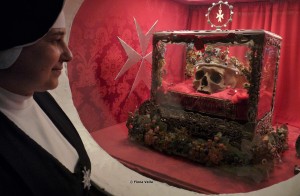 Wara li rriċerkajt din it-tema, ma stajtx ma nżurx il-post fejn tinsab din ir-relikwa. Akkost li l-monasteru jiġbor fih sorijiet tal-klawsura, it-talba tiegħi ġiet milqugħa mal-ewwel u ma domtx ma sibt ruħi wiċċ imb’wiċċ ma’ dan il-bniedem li tant nies jitkellmu b’rispett lejh.
Wara li rriċerkajt din it-tema, ma stajtx ma nżurx il-post fejn tinsab din ir-relikwa. Akkost li l-monasteru jiġbor fih sorijiet tal-klawsura, it-talba tiegħi ġiet milqugħa mal-ewwel u ma domtx ma sibt ruħi wiċċ imb’wiċċ ma’ dan il-bniedem li tant nies jitkellmu b’rispett lejh.“Kull sena, jiġu għadd ta’ nies minn madwar l-Ewropa kollha biex iżuru din ir-relikwa,” infurmatni l-Madre Prijoressa Sr. Agnese Zammit OSS tal-Monasteru ta’ Sant’Ursula l-Belt.
 “F’April li għadda, kellna anki żjara statali mill-Prinċep u Gran Mastru tal-Ordni ta’ San Ġwann ta’ Ġerusalemm, ta’ Rodi u ta’ Malta, Frá. Matthew Festing. Għal din l-okkażjoni, peress li aħna sorijiet tal-Ordni, nilbsu l-abitu statali li jinkludi l-istolone u l-manto di punta”.
“F’April li għadda, kellna anki żjara statali mill-Prinċep u Gran Mastru tal-Ordni ta’ San Ġwann ta’ Ġerusalemm, ta’ Rodi u ta’ Malta, Frá. Matthew Festing. Għal din l-okkażjoni, peress li aħna sorijiet tal-Ordni, nilbsu l-abitu statali li jinkludi l-istolone u l-manto di punta”.Kull sena, fit-13 t’Ottubru, dawn is-sorijiet jorganizzaw quddiesa solenni b’rispett lejn Patri Gerard. Għal din iċ-ċelebrazzjoni, jattendu l-Kavallieri ta’ San Ġwann kollha li joqogħdu Malta u mill-ġdid huma jilbsu l-abitu statali.
Ħadd ma jaf kien kien jidher wiċċu
Ħadd ma jaf fiċ-ċert kif kien wiċċ Patri Gerard. Madanakollu, sforz ir-rispett kbir li n-nies minn dejjem kellhom lejh, saru diversi pitturi tiegħu fejn wiċċu ġie mmaġinat mill-artisti. Wieħed minn dawn il-kwadri li juri lil Patri Gerard qed jilqa’ lil Godfrey de Bouillon, Duka ta’ Lower Lorraine u mexxej tal-Ewwel Kruċjata ġie maħdum mill-pittur magħruf Antoine De Favray u jinsab esebit fil-Mużew Nazzjonali tal-Arti fi Triq Nofsinhar il-Belt.
Sadanittant, jekk qanqaltilkhom biżżejjed kurżità, tistgħu taraw ukoll kopja ta’ dan il-kwadru fuq il-blog tal-Assedju l-Kbir ta’ Heritage Malta – www.heritagemalta.org/1565
Apparti kurżitajiet simili relatati mal-Ordni ta’ San Ġwann, f’dan il-blog tistgħu ssegwu wkoll rakkonti ġurnata b’ġurnata ta’ dak li għaddew minnu Malta, il-Maltin u l-Kavallieri waqt il-perjodu aħrax tal-Assedju l-Kbir li beda f’Mejju u ntemm f’Settembru tal-1565.
(Dan l-artiklu ġie ppubblikat fis-sensiela MINN RITRATT (12 il-parti) fit-Torċa tas-7 ta’ Ġunju 2015)
Travelogue
Archives
| M | T | W | T | F | S | S |
|---|---|---|---|---|---|---|
| « Jan | ||||||
| 1 | 2 | 3 | 4 | 5 | 6 | 7 |
| 8 | 9 | 10 | 11 | 12 | 13 | 14 |
| 15 | 16 | 17 | 18 | 19 | 20 | 21 |
| 22 | 23 | 24 | 25 | 26 | 27 | 28 |
| 29 | 30 | |||||
Recent Posts
- A MATTER OF FATE
- MALTA’S PREHISTORIC TREASURES
- THE MAGIC IS IN THE DETAIL
- THE SELLING GAME
- NEVER FORGOTTEN
- Ġrajjiet mhux mitmuma – 35 sena mit-Traġedja tal-Patrol Boat C23
- AN UNEXPECTED VISIT
- THE SISTERS OF THE CRIB
Comments
- Pauline Harkins on Novella – Li kieku stajt!
- admin on IL-KARNIVAL TRAĠIKU TAL-1823
- Albert on IL-KARNIVAL TRAĠIKU TAL-1823
- Martin Ratcliffe on Love in the time of war
- admin on 24 SENA ILU: IT-TRAĠEDJA TAL-PATROL BOAT C23